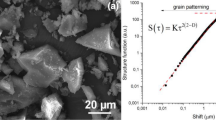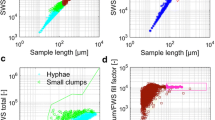Abstract
The use of white-rot fungi for biodegradative research and developmental application requires seeding with a suitable inoculum. This paper presents a new method for the quantitative analysis of a mycelial inoculum composed of homogenized hyphal fragments. Our method is premised on a power-law behaviour between frequency and the size of these mycelial fragments. It is shown that the fragment distribution profile can be determined by regression to give the fractal fragmentation dimension, D. The influence of homogenizer speed was also investigated over a range from 8333 rpm to 25 000 rpm, which corresponds to a shear rate range of 13.9 × 103 to 41.7 × 103 s−1. The highest D value was shown at a shear rate of 27.8 × 103 s−1 for 30 s, implying greatest homogeneity in the size distribution function over the measured range (0–500 μm2). As shear force and duration increases (up to a threshold value) the production of small fragments is facilitated with a corresponding decrease in the D value. The slope relation express the fragment diversity whereas the reciprocal fractal valie characterizes the distribution size probability. Image-analysis methodology is described and the implications of a fractal description of a mycelial inoculum are also considered.
Similar content being viewed by others
References
Aust SD (1990) Degradation of environmental pollutants by Phanerochaete chrysosporium. Microb Ecol 20:197–209
Agosín E, Odier E (1985) Solid-state fermentation, lignin degradation and resulting digestibility of wheat straw fermented by selected white-rot fungi. Appl Microbiol Biotechnol 21:397–403
Brown WK (1986) Universal fragmentation. Astrophys Space Sci 121:351–355
Bumpus JA (1989) Biodegradation of polycyclic aromatic hydrocarbons by Phanerochaete chrysosporium. Appl Environ Microbiol 55:154–158
Bumpus JA, Brock BJ (1988) Biodegradation of crystal violet by the white rot fungus Phanerochaete chrysosporium. Appl Environ Microbiol 54:1143–1150
Burrough PA (1989) Fractals and Geochemistry. In: Avnir D (ed) The fractal approach to heterogeneous chemistry — surgaces, colloids, polymers. Wiley, Chichester, p 391
Cripps C, Bumpus JA, Aust SD (1990) Biodegradation of azo and heterocyclic dyes by Phanerochaete chrysosporium. Appl Environ Microbiol 56:1114–1118
Cornwell KL, Tinland-Butez M-F, Tardone PJ, Cabasso I, Hammel KE (1990) Lignin degradation and lignin peroxidase production in cultures of Phanerochaete chrysosporium immobilized on porous ceramic supports. Enzyme Microb Technol 12:916–920
Davis DR, Ryan EV (1990) On collisional disruption: experimental results and scaling laws. Icarus 83:156–182
Feder J, Jøssang T (1985) A reversible reaction limited step in irreversible immunoglobulin aggregation. In: Pynn R, Skjeltorp A (eds) Scaling phenomena in disordered systems. NATO ASI Series B, Physics; vol 133. Plenum Press, New York, pp 99–131
Frontier S (1987) Applications of fractal theory to ecology. In: Legendre P, Legendre L (eds) Developments in numerical ecology. NATO ASI G14. Springer, Berlin Heidelberg New York, p 335
Fuhrer B (1985) A field companion to Australian fungi. Five Mile Press, Hawthorn, Victoria, Australia, p 127
Glaser JA (1990) Hazardous waste degradation by wood degrading fungi. In: Kamely D, Chakrabarty A, Omenn GS (eds) Biotechnology and biodegradation. Gulf Publishing, Houston, pp 267–284
Glenn JK, Gold MH (1983) Decolorization of several polymeric dyes by the lignin-degrading basidiomycete Phanerochaete chrysosporium. Appl Environ Microbiol 45:1741–1747
Gonzalez RC, Wintz P (1987) Digital image processing, 2nd edn. Addison-Wesley, Reading, Mass., pp 190–193
Hammel KE, Kalyanaraman B, Kirk TK (1986) Oxidation of polycyclic aromatic hydrocarbons and dibenzo[p]-dioxins by Phanerochaete chrysosporium ligninase. J Biol Chem 261:16948–16952
Hastings HM, Pekelney R, Monticciolo R, Kannon Vun D, Monte del D (1982) Time scales, persistence and patchiness. Biosystems 15:281–289
Hegde SG, Lokesha R, Ganeshaiah KN (1991) Seed size distribution in plants: an explanation based on fractal geometry. Oikos 62:100–101
Jäger A, Croan S, Kirk TK (1985) Production of ligninases and degradation of lignin in agitated submerged cultures of Phanerochaete chrysosporium. Appl Environ Microbiol 50:1274–1278
Jähne B (1991) Digital image processing — concepts, algorithms and scientific applications. Springer, Berlin Heidelberg New York, pp 194
Jones CL, Lonergan GT, Mainwaring DE (1992) The use of image analysis for spore counts of white-rot fungi. Biotechnol Tech 6:417–423
Jones P, Batool A, Shahab A, Trinci APJ, Moore D (1988) Effect of polymeric additives, especially Junlon and Hostacerin, on growth of some basidiomycetes in submerged culture. Trans Br Mycol Soc 90:577–583
Kaye BH (1987) Fine particle characterization aspects of predictions affecting the efficiency of microbiological mining techniques. Powder Technol 50:177–191
Kaye BH (1989) A random walk through fractal dimensions, 1st edn. VCH, Weinheim
Kirk TK, Croan S, Tien M (1986) Production of multiple ligninases by Phanerochaete chrysosporium: effect of selected growth conditions and use of a mutant strain. Enzyme Microb Technol 8:27–32
Korčak J (1940) Deux types fondamentaux de distribution statistique. Bull Inst Int Stat 30:295–299
Lechevalier HA, Roisen FJ (1989) Stains for light microscopy. In: O'Leary W (ed) Practical handbook of microbiology. CRC Press, Boca Raton, Fla. p 317
Lewandowski GA, Armenante PM, Pak D (1990) Reactor design for hazardous waste treatment using a white rot fungus. Water Res 24:75–82
Linko S (1988) Production and characterization of extracellular lignin peroxidase from immobilized Phanerochaete chrysosporium in a 10–1 bioreactor. Enzyme Microb Technol 10:410–417
Macdonald R, Westerman J (1979) A field guide to fungi of South-Eastern Australia. Thomas Nelson, Melbourne, Australia, p 112
Mandelbrot BB (1975) Stochastic models for the earth's relief, the shape and the fractal dimension of the coastlines, and the number-area rule for islands. Proc Natl Acad Sci USA 72:3825–3828
Mandelbrot BB (1983) The fractal geometry of nature. Review edn of Fractals (1977). Freeman, New York
Matsushita M (1985) Fractal viewpoint of fracture and accreation. J Phys Soc Jpn 54:857–860
Montroll EW, Shlesinger MF (1982) On 1/f noise and other distributions with long tails. Proc Natl Acad Sci USA 79:3380–3383
Nishida T, Kashino Y, Mimura A, Takahara Y (1988) Lignin biodegradation by wood-rotting fungi I. Screening of lignin-degrading fungi. Mokuzai Gakkaishi 34:530–536
Pynn R, Skjeltorp A (eds) (1985) Scaling phenomena in disordered systems. NATO ASI Series B, Physics, vol 133. Plenum Press, New York
Raan AFJ van (1990) Fractal dimension of co-citations. Nature 347:626
Ryan EV, Hartmann WK, Davis DR (1991) Impact experiments 3: catastrophic fragmentation of aggregate targets and relation to asteroids. Icarus 94:283–298
Scholz CH, Mandelbrot BB (eds) (1989) Fractals in geophysics. Birkhauser, Boston
Solomons GL (1975) Submerged culture production of mycelial biomass. In: Smith JE, Berry DR (eds) The filamentous fungi, vol 1. Industrial mycology. Edward Arnold, London, pp 249–264
Sugihara G, May RM (1990) Applications of fractals in ecology. TREE (Trends in Ecology and Evolution) 5:79–86
Turcotte DL (1986) Fractals and fragmentation. J Geophys Res 91:1921–1926
Venkatadri R, Irvine RL (1990) Effect of agitation on ligninase activity and ligninase production by Phanerochaete chrysosporium. Appl Environ Microbiol 56:2684–2691
Voss RF, Laibowitz RB, Allessandrini EI (1982) Fractal (scaling) clusters in thin gold films near the percolation threshold. Phys Rev Lett 49:1441–1448
Voss RF, Laibowitz RB, Allessandrini EI (1985) Fractal geometry of percolation in thin gold films. In: Pynn R, Skjeltorp A (eds) Scaling phenomena in disordered systems. NATO ASI Series B, Physics; vol 133. Plenum Press, New YOrk
Zipf GK (1949) Human behavior and the principle of least effort —an introduction to human ecology. Hafner Publishing Company, New York (reprinted 1965)
Zweck S, Hüttermann A, Chet I (1978) A convenient method for preparing inocula of homogenized mycelia. Exp Mycol 2:377–378
Author information
Authors and Affiliations
Rights and permissions
About this article
Cite this article
Jones, C.L., Lonergan, G.T. & Mainwaring, D.E. Mycelial fragment size distribution: an analysis based on fractal geometry. Appl Microbiol Biotechnol 39, 242–249 (1993). https://doi.org/10.1007/BF00228613
Received:
Accepted:
Issue Date:
DOI: https://doi.org/10.1007/BF00228613




